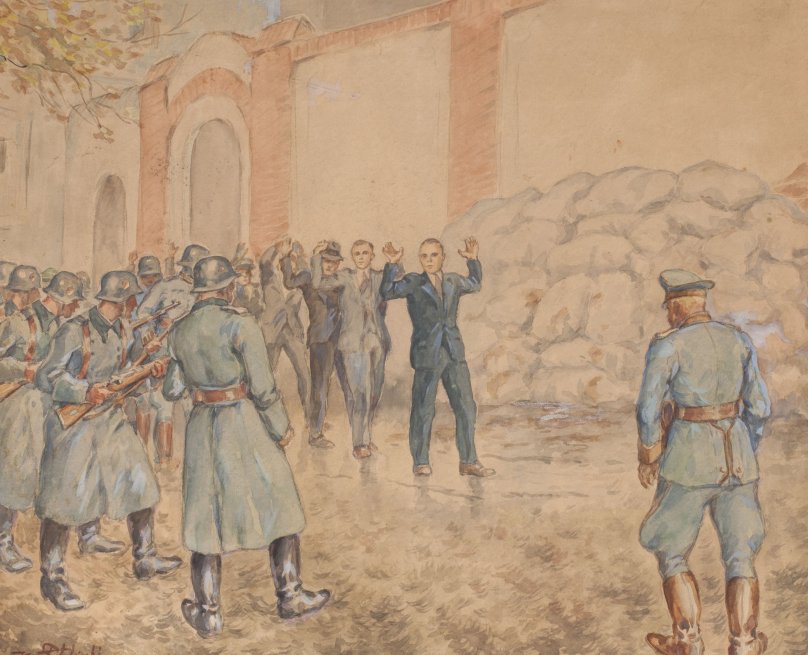Tragic October 1939

Artur Michalak, historian
Operation Tannenberg was the first planned mass extermination operation carried out by the Germans during World War II.
Its aim was to physically eliminate the Polish leadership classes, which had been included in the so-called proscription lists before the war. By the end of 1939, in the territories of the Second Polish Republic occupied by the Third Reich, the Germans murdered almost 55,000 Polish citizens.
After crossing the Polish border, individual Einsatzgruppen supplemented the proscription lists received in Berlin with lists of local social activists and anti-German Poles. The source of information were Germans living in the Second Polish Republic before the war.
21 October 1939 in Leszno
Operation Tannenberg lasted from the beginning of the war, the greatest intensity of executions in Greater Poland took place on 20 – 23 October. On 21.10.1939, the 14th commando of Einsatzgruppe VI under the command of Gerhard Flesch appeared in Leszno. The defendants were the most prominent citizens of Leszno, who had been arrested earlier. The main purpose of the planned execution was to intimidate the Polish society. The Germans hastily convened a summary court with the commander of the Einsatzkommando as its chairman, the local Germans were the consultors of the arrested Poles, among others: pastor Wolfgang Bickerich. The hearing took place in the Sułkowski Palace. Out of the total number of 53 people on trial, 20 were sentenced to death. The firing squad of the Einsatzkommando carried out a public execution on the same day, at Tadeusz Kościuszko Square, under the prison wall.
Below: Photographs by Gerhard Flesch, public domain
Operation Tannenberg was the first planned mass extermination operation carried out by the Germans during World War II.
Its aim was to physically eliminate the Polish leadership classes, which had been included in the so-called proscription lists before the war. By the end of 1939, in the territories of the Second Polish Republic occupied by the Third Reich, the Germans murdered almost 55,000 Polish citizens.
After crossing the Polish border, individual Einsatzgruppen supplemented the proscription lists received in Berlin with lists of local social activists and anti-German Poles. The source of information were Germans living in the Second Polish Republic before the war.
21 October 1939 in Leszno
Operation Tannenberg lasted from the beginning of the war, the greatest intensity of executions in Greater Poland took place on 20 – 23 October. On 21.10.1939, the 14th commando of Einsatzgruppe VI under the command of Gerhard Flesch appeared in Leszno. The defendants were the most prominent citizens of Leszno, who had been arrested earlier. The main purpose of the planned execution was to intimidate the Polish society. The Germans hastily convened a summary court with the commander of the Einsatzkommando as its chairman, the local Germans were the consultors of the arrested Poles, among others: pastor Wolfgang Bickerich. The hearing took place in the Sułkowski Palace. Out of the total number of 53 people on trial, 20 were sentenced to death. The firing squad of the Einsatzkommando carried out a public execution on the same day, at Tadeusz Kościuszko Square, under the prison wall.
Below: Photographs by Gerhard Flesch, public domain
The following people died then:
Marcin Adamski
Ludwik Antoniak
Bruno Antoni Bartoszkiewicz
Marcin Günter
Zygfryd Hańca
Bolesław Karpiński
Wacław Kęsicki
Bronisław Kotlarski
Józef Łukowski
Józef Marcinkowski
Leon Marcinkowski
Feliks Michalak
Władysław Nowak
Jan Nowicki
Mieczysław Jerzy Opatrny
Stefan Samolewski
Józef Stotko
Stanisław Szal
Maksymilian Trendowicz
Tomasz Wachowski
Marcin Adamski
Ludwik Antoniak
Bruno Antoni Bartoszkiewicz
Marcin Günter
Zygfryd Hańca
Bolesław Karpiński
Wacław Kęsicki
Bronisław Kotlarski
Józef Łukowski
Józef Marcinkowski
Leon Marcinkowski
Feliks Michalak
Władysław Nowak
Jan Nowicki
Mieczysław Jerzy Opatrny
Stefan Samolewski
Józef Stotko
Stanisław Szal
Maksymilian Trendowicz
Tomasz Wachowski

Report on the execution carried out on 21 October 1939 (Saturday) in Leszno (Chief Prosecutor Maksymilian Verlohren):
"20 defendants were brought before the court again. The chairman [Gerhard Flesch] stated that they were sentenced to death for incitement and acting against the Germans, and the sentence would be carried out immediately. Three buckets were placed in the courtroom. The convicts had to put headgear and all personal valuables in them. In groups of 10 people, they were then led to the so-called castle square in front of the courthouse... [...]
A firing squad of 30 policemen was waiting in the square. Sandbags were placed to protect the wall against bullets. The condemned stood facing the wall with their hands raised. In the first group, one of the condemned was not hit and was shot again. Then the police doctor pronounced death. However, in most cases it was necessary to finish off with a pistol. A commando of Polish prisoners loaded the bodies onto a prepared vehicle. A second group of ten convicts was brought in and shot in a similar manner. The population of Leszno was informed about the session of the summary court and about the execution of the sentences the previous evening. People watched the execution from a distance of 40-50 meters. There were no riots...”
Jerzy Zielonka, W cieniu swastyki, Leszno 2004, pp. 96-99.
A firing squad of 30 policemen was waiting in the square. Sandbags were placed to protect the wall against bullets. The condemned stood facing the wall with their hands raised. In the first group, one of the condemned was not hit and was shot again. Then the police doctor pronounced death. However, in most cases it was necessary to finish off with a pistol. A commando of Polish prisoners loaded the bodies onto a prepared vehicle. A second group of ten convicts was brought in and shot in a similar manner. The population of Leszno was informed about the session of the summary court and about the execution of the sentences the previous evening. People watched the execution from a distance of 40-50 meters. There were no riots...”
Jerzy Zielonka, W cieniu swastyki, Leszno 2004, pp. 96-99.